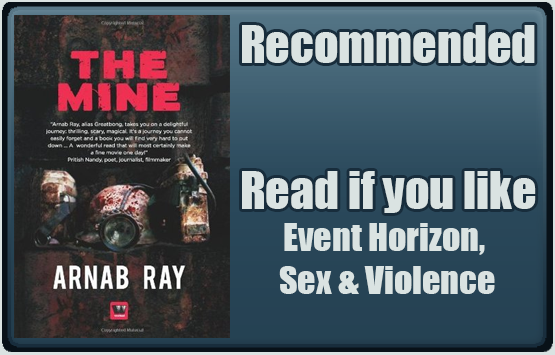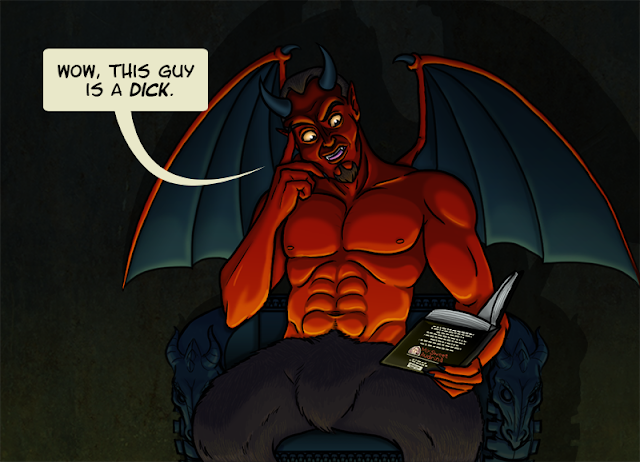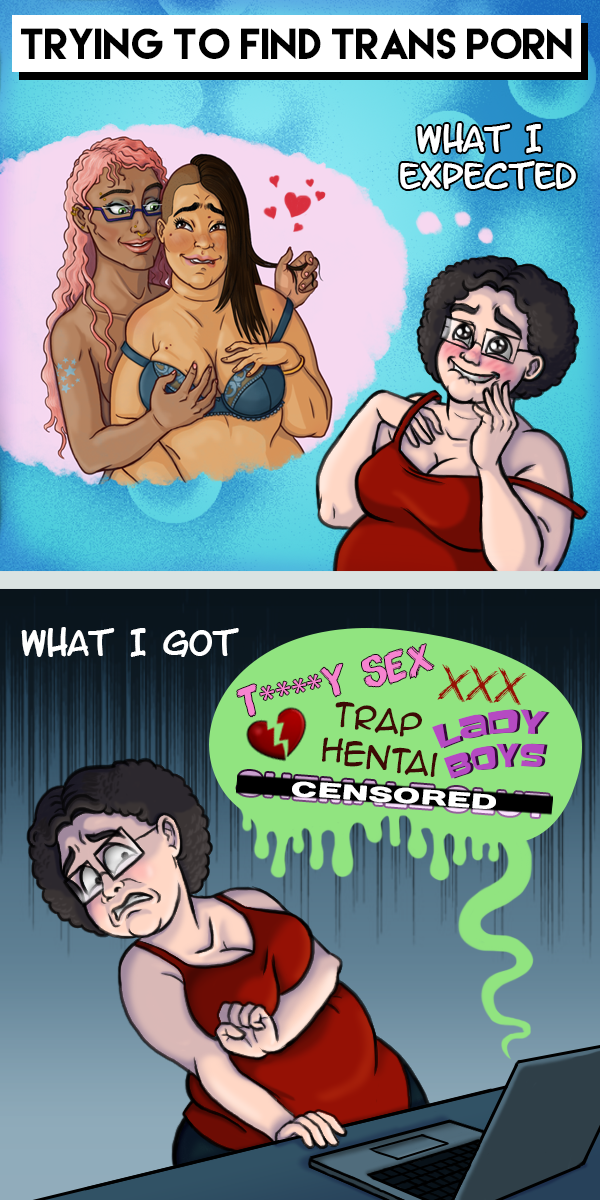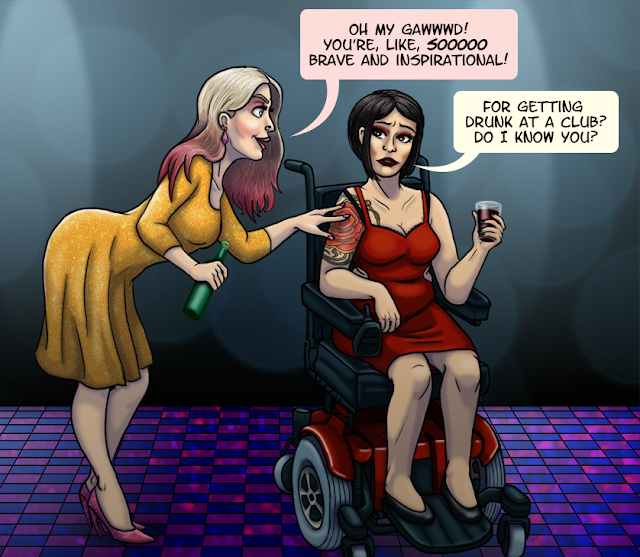Formats: Print, digital
Publisher: Westland (Indian publisher now owned by Amazon)
Genre: Blood & Guts (Gorn), Psychological Horror, Occult
Audience: Adult/Mature
Diversity: South Asian/Desi/Indian, Disabled character (uses a wheelchair due to partial paralysis, mute/Aphonia)
Takes Place in: Thar Desert, Rajasthan, India
Content Warnings: Abelism, Bullying, Cannibalism, Child Abuse, Child Death, Child Endangerment, Death, Drug Use/Abuse, Forced Captivity, Illness, Gaslighting, Gore, Kidnapping, Medical Torture/Abuse, Medical Procedures, Mental Illness, Self-Harm, Rape/Sexual Assault, Sexism, Slurs, Slut-Shaming, Stalking, Suicide, Torture, Violence, Xenophobia (Highlight to view)
Blurb:
| At a secret mining facility somewhere in the deserts of Rajasthan, an ancient place of worship, with disturbing carvings on its dome, is discovered buried deep inside the earth. Soon the miners find themselves in the grip of terrifying waking nightmares. One tries to mutilate himself. Worse follows. Five experts are called in to investigate these strange occurrences. Sucked into a nightmare deep underground, they embark on a perilous journey; a journey that will change them forever, bringing them face-to-face with the most shattering truth of them all… The greatest evil lies deep inside. |
Imagine combining Event Horizon with Agatha Christie's And Then There Were None then mixing in the criminally underrated film Below. Set it in a mine deep below the Great Indian Desert and you'll get an idea of what you're in for in Arnab Ray's horrifying, claustrophobic, sex-filled gore-fest of a novel about five adults and one little girl trapped underground with their guilt.
The Mine starts out with Samar, a rich recluse specializing in industrial security, wallowing in his grief after the disappearance of his daughter and the death of his wife. Yeah, Samar has shit luck. A mysterious man named Arnold Paul (whose name I kept reading as Arnold Palmer) finally
Joining Samar are Dr. Karan Singh Rathore, a diplomatic and laid back older gentleman who specializes in infectious diseases; Dr. Anjali Menon, a widowed archeologist who brought her disabled daughter, Anya, along; Dr. Akshay More, an arrogant and obnoxious assistant professor in forensic toxicology; and Dr. Preeti Singh, a short-tempered psychologist with a surprising lack of people skills. The group has been brought together to give their expert opinion on a series of deadly accidents that seem to have been caused by the discovery of an ancient, creepy temple the miners are too afraid to go near. A temple that also happens to be covered in explicit carvings of naked women being tortured and killed, because whomever created the damn thing is sexist and gross. If that wasn't ominous enough, the director of the mine is named Lilith Adams. While it's fully possible her parents were just uncreative goths from the early 00's, it's far more likely that Ms. Adams just picked the most obvious evil pseudonym since Alucard and Lou C. Pher.
At this point, most people would've noped the fuck out of there, but Samar and the scientists have clearly never seen a horror movie in their lives and are too wrapped up in their own issues to notice the whole situation has more red flags than a May Day parade in Moscow. The mine could not be more obviously evil if it had "Gateway to Hell" in big florescent lights over the entrance, ominous music playing in the background, and a bunch of demons chilling in the conference room. Then again, these are people who willingly followed a creepy stranger into the middle of nowhere to visit his sketchy underground dungeon (literally, the workers are all criminals and aren't allowed to leave until their contracts are up) because Paul/Palmer promised them candy/money. Little kids have more street smarts than this group, so I shouldn't be surprised they're completely oblivious to danger.
Her name is Lilith, what did you guys expect?
The explosions cause the security systems to engage, sealing the group inside with a series of death traps. Because why wouldn't you want death traps in an already dangerous mine? On top of everything, an experimental gas that causes super human strength and insanity is being pumped through the A/C, which frankly, feels like overkill to me, but hey, they can run their portal to hell however they want. After their initial panic, presumably followed by the realization that they really should have seen all of this coming, the survivors formulate a plan to navigate the traps and make it to the surface. They're slightly hindered by the fact they have to trust each other and work together to make it out, and most of them are deceitful, suspicious, assholes, not to mention all the stupid puzzle traps that were apparently inspired by 80s video games. One such puzzle involves trying to obtain acid vials while avoiding motion activated laser and an electrified floor, and if you succeed you'll be rewarded with a chainsaw, which may be useful later. Unfortunately in this "game" their are no save points or extra lives.
What follows is about what you'd expect for a book about trying to escape from a possibly haunted mine with a bunch of jerks, but the predictability doesn't make the story any less suspenseful or gripping. But face it, if you're reading this book, you're looking for creative deaths, not creative storytellin, and boy, does Ray deliver there. Besides, the true mystery doesn't lie in their Aeneas-like journey through the mine, but in each character's backstory, all of which are slowly revealed as they try to escape the subterranean deathtrap. Each of the adults has done something criminal and escaped punishment, and have been struggling with their guilt ever since. The quality of the backstories varies, with some characters (like Akshay and Preeti) getting plenty of focus, while Anjali gets very little characterization beyond "the aloof mom". So too do their sins seem to be of differing severity. Some of the survivors have committed crimes so awful as to make them irredeemable, while others are more sympathetic and their sins, while still terrible, are still at least partly understandable. This disparity seems a little unfair as it means at least some of the group will potentially suffer a gruesome death (at least according to the carvings in the temple) over something that would normally earn them less than 15 years in prison (at least in the US, not sure about the Indian judicial system). It's not that their crimes aren't bad, they just don't seem to merit a sentence of being reduced to a puddle of bloody viscera.
We never really learn if the mine is truly being controlled by a demonic entity or if the group's guilt and paranoia (fueled by the hallucinogenic gas) is causing them to attribute bad luck to malicious forces and see things that aren't there. Samar even suggests that the whole thing is an unethical experiment by the government to test their new gas on subjects no one will miss, as there are far too many coincidences for mere random chance, and the temple may be a fake created to amp up their fear levels. Since none of the characters are able to trust their own senses, making them unreliable narrators, arguments could be made for either scenario, making the story even more spooky and disturbing. Monsters are scary, but they're even scarier when you can't even tell if they're real or simply the imaginary scapegoats of guilt-ridden, paranoid people. Even more frightening, Ray argues, are the depths of human cruelty and depravity, which are explored in each character's backstory. Though that may just be an excuse to squeeze more gore out of the story.
The Mine does an excellent job balancing itself between psychological horror and splatterpunk. The true scares lie in the book's creepy atmosphere, suspense, and the characters slowly succumbing to madness; the over-the-top gore is simply dessert. Unfortunately, this otherwise perfect blend of horror comes with as huge helping of misogyny. Yuck. Look, I'm fully willing to admit I'm part of the lowest common denominator who just wants to see heads exploding like overripe cherries and attractive people boning, but that doesn't mean I like sexism. Unfortunately, more often than not, the three seem to go hand in hand, much to the frustration of female horror fans, and other, more enlightened individuals who just happen to like hot sex and lots of blood. Ray isn't as bad some other authors out there, the violence is pretty evenly split between the genders and there aren't any scenes of knife-wielding killers chasing half naked women. He even manages to handle the subject of sexual assault fairly well, choosing to focus more on the problematic culture of victim-blaming and men who feel entitled to women's bodies rather than the rape itself. But he struggles with creating believable female characters, defining them by their relationships with men, and them victimizing them. Both of the female scientists have backstories that involve abuse and mistreatment at the hands of men, and instead of being written as strong, survivors, they both come off as bitter, man-haters. Apparently Ray subscribes to the theory that in order to be "strong" a woman must act rude, aloof, aggressive, and despise an entire gender, with the exception of that one special man who tames her with his magical penis. Which is why both Anjali and Pretti act like complete jerks, with Pretti especially flying off the handle at every perceived slight (she must be a great psychologist), and basically being awful to everyone except, ironically, Akshay whom she latches onto almost immediately (despite the fact that he's literally just the worst). Despite all her bluster, Pretti still falls quickly into the role of helpless victim in need of a man's protection at the first sign of danger. It's really embarrassing. I guess she can't help it because she's an emotional female with a hysterical uterus or some such nonsense. The women in the story are all described as being gorgeous, but only one male character is described as being very attractive, the wholly unlikable Akshay, and that's only because his appearance is supposed to reinforce how vain and materialistic he is. Many of the women are also incredibly horny, even minor characters, like Tanya the gold-digging nurse, and Ray paradoxically has no problem slut-shaming them for it (apparently enjoying sex is sinful enough to get you murdered by the mine), even though he later demonizes other characters for doing the same thing. Maybe the mine is just super slut shame-y. The unearthed temple certainly implies that someone behind the scenes hates women.
The women in the story seem less like real people and more like a weird combination of straw-feminists and male masturbatory material, with Ray putting way too much emphasis on their appearance, sex drives, and relationships with men. Then of course we have Anya, who, while thankfully not a sex object, is still treated as an object nonetheless. She barely gets any characterization, and doesn't communicate even through sign language or writing, she's just a blank slate for Samar to project his weird daughter obsession onto. It's doubly problematic since Samar seems to use Anya's disability as an excuse to treat her like a life-sized doll he can love, protect, and turn into his replacement daughter. Because she's mute he assumes she has nothing to say, and because she doesn't walk he thinks she's completely helpless. We don't even get to learn what she's thinking, or how she feels about Samar treating her as some sort of second chance, because, unlike the other characters who all get their turn in the spotlight of the limited, third-person narrative, Anya is completely ignored. At least she gets a little bit of a role later on (which I won't spoil). Miraculously, Lilith Adams is the only female character who is neither a victim, nor a sex fantasy, and is described only as being terrifying, intense, and very much in charge, much like her namesake.
What follows is about what you'd expect for a book about trying to escape from a possibly haunted mine with a bunch of jerks, but the predictability doesn't make the story any less suspenseful or gripping. But face it, if you're reading this book, you're looking for creative deaths, not creative storytellin, and boy, does Ray deliver there. Besides, the true mystery doesn't lie in their Aeneas-like journey through the mine, but in each character's backstory, all of which are slowly revealed as they try to escape the subterranean deathtrap. Each of the adults has done something criminal and escaped punishment, and have been struggling with their guilt ever since. The quality of the backstories varies, with some characters (like Akshay and Preeti) getting plenty of focus, while Anjali gets very little characterization beyond "the aloof mom". So too do their sins seem to be of differing severity. Some of the survivors have committed crimes so awful as to make them irredeemable, while others are more sympathetic and their sins, while still terrible, are still at least partly understandable. This disparity seems a little unfair as it means at least some of the group will potentially suffer a gruesome death (at least according to the carvings in the temple) over something that would normally earn them less than 15 years in prison (at least in the US, not sure about the Indian judicial system). It's not that their crimes aren't bad, they just don't seem to merit a sentence of being reduced to a puddle of bloody viscera.
We never really learn if the mine is truly being controlled by a demonic entity or if the group's guilt and paranoia (fueled by the hallucinogenic gas) is causing them to attribute bad luck to malicious forces and see things that aren't there. Samar even suggests that the whole thing is an unethical experiment by the government to test their new gas on subjects no one will miss, as there are far too many coincidences for mere random chance, and the temple may be a fake created to amp up their fear levels. Since none of the characters are able to trust their own senses, making them unreliable narrators, arguments could be made for either scenario, making the story even more spooky and disturbing. Monsters are scary, but they're even scarier when you can't even tell if they're real or simply the imaginary scapegoats of guilt-ridden, paranoid people. Even more frightening, Ray argues, are the depths of human cruelty and depravity, which are explored in each character's backstory. Though that may just be an excuse to squeeze more gore out of the story.
The Mine does an excellent job balancing itself between psychological horror and splatterpunk. The true scares lie in the book's creepy atmosphere, suspense, and the characters slowly succumbing to madness; the over-the-top gore is simply dessert. Unfortunately, this otherwise perfect blend of horror comes with as huge helping of misogyny. Yuck. Look, I'm fully willing to admit I'm part of the lowest common denominator who just wants to see heads exploding like overripe cherries and attractive people boning, but that doesn't mean I like sexism. Unfortunately, more often than not, the three seem to go hand in hand, much to the frustration of female horror fans, and other, more enlightened individuals who just happen to like hot sex and lots of blood. Ray isn't as bad some other authors out there, the violence is pretty evenly split between the genders and there aren't any scenes of knife-wielding killers chasing half naked women. He even manages to handle the subject of sexual assault fairly well, choosing to focus more on the problematic culture of victim-blaming and men who feel entitled to women's bodies rather than the rape itself. But he struggles with creating believable female characters, defining them by their relationships with men, and them victimizing them. Both of the female scientists have backstories that involve abuse and mistreatment at the hands of men, and instead of being written as strong, survivors, they both come off as bitter, man-haters. Apparently Ray subscribes to the theory that in order to be "strong" a woman must act rude, aloof, aggressive, and despise an entire gender, with the exception of that one special man who tames her with his magical penis. Which is why both Anjali and Pretti act like complete jerks, with Pretti especially flying off the handle at every perceived slight (she must be a great psychologist), and basically being awful to everyone except, ironically, Akshay whom she latches onto almost immediately (despite the fact that he's literally just the worst). Despite all her bluster, Pretti still falls quickly into the role of helpless victim in need of a man's protection at the first sign of danger. It's really embarrassing. I guess she can't help it because she's an emotional female with a hysterical uterus or some such nonsense. The women in the story are all described as being gorgeous, but only one male character is described as being very attractive, the wholly unlikable Akshay, and that's only because his appearance is supposed to reinforce how vain and materialistic he is. Many of the women are also incredibly horny, even minor characters, like Tanya the gold-digging nurse, and Ray paradoxically has no problem slut-shaming them for it (apparently enjoying sex is sinful enough to get you murdered by the mine), even though he later demonizes other characters for doing the same thing. Maybe the mine is just super slut shame-y. The unearthed temple certainly implies that someone behind the scenes hates women.
The women in the story seem less like real people and more like a weird combination of straw-feminists and male masturbatory material, with Ray putting way too much emphasis on their appearance, sex drives, and relationships with men. Then of course we have Anya, who, while thankfully not a sex object, is still treated as an object nonetheless. She barely gets any characterization, and doesn't communicate even through sign language or writing, she's just a blank slate for Samar to project his weird daughter obsession onto. It's doubly problematic since Samar seems to use Anya's disability as an excuse to treat her like a life-sized doll he can love, protect, and turn into his replacement daughter. Because she's mute he assumes she has nothing to say, and because she doesn't walk he thinks she's completely helpless. We don't even get to learn what she's thinking, or how she feels about Samar treating her as some sort of second chance, because, unlike the other characters who all get their turn in the spotlight of the limited, third-person narrative, Anya is completely ignored. At least she gets a little bit of a role later on (which I won't spoil). Miraculously, Lilith Adams is the only female character who is neither a victim, nor a sex fantasy, and is described only as being terrifying, intense, and very much in charge, much like her namesake.
 |
| This definitely feels like a stranger danger situation. |
So the female characters are about as well written as you'd expect from a male author who doesn't know how women work, and the whole "helpless, sick wheelchair girl" trope is super problematic. It's not the worst treatment of women I've seen in splatterpunk, but I'd still prefer to enjoy my blood and guts without the side of sexism. I mean, I don't think it's an unreasonable request. The writing is still pretty good, and it's definitely the scariest book I've read so far this year. The Mine is also one of only a few Indian horror novels I've been able to find in English. Whether that's enough to overshadow the book's problem areas, however, is up to the individual reader.

















